At service today, Lyndonville native praised for ‘selfless sacrifice’ – 79 years after dying in POW camp
Gerald ‘Bud’ Hamann, whose remains were recently identified in Philippines, survived 60-mile Bataan Death March, succumbed to dysentery
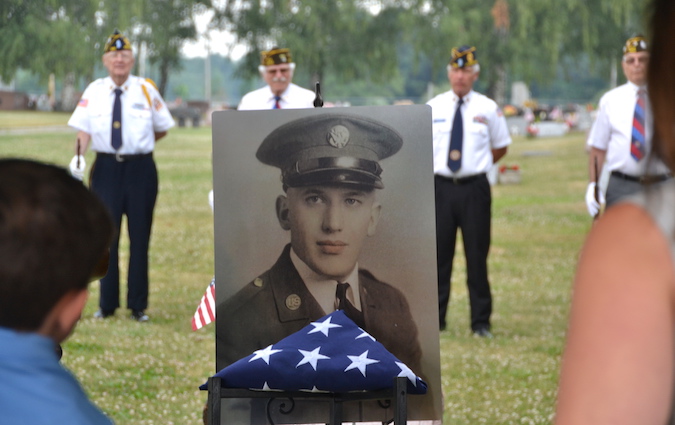
Photos by Tom Rivers: The portrait of Gerald “Bud” Hamann is positioned near his grave spot at Lynhaven Cemetery during a service today for him. His remains were recently identified in a mass grave in the Philippines. Honor Guard members from Orleans County are in the background.
LYNDONVILLE – Nearly 79 years after his death in a Japanese prisoner of war camp, Gerald “Bud” Hamann was given a service at Lynhaven Cemetery today.
Hamann survived the arduous Bataan Death March over 60 miles on foot, and then a 25-mile ride standing up in a boxcar packed with fellow soldiers who were prisoners. When he finally made it to the prisoner of war camp at Cabanatuan, Hamann would die from dysentery on July 25, 1942.
He was thrown in a mass grave with over a 100 other soldiers. His remains were positively identified after a niece, Kathy Kage, submitted DNA through ancestry.com.
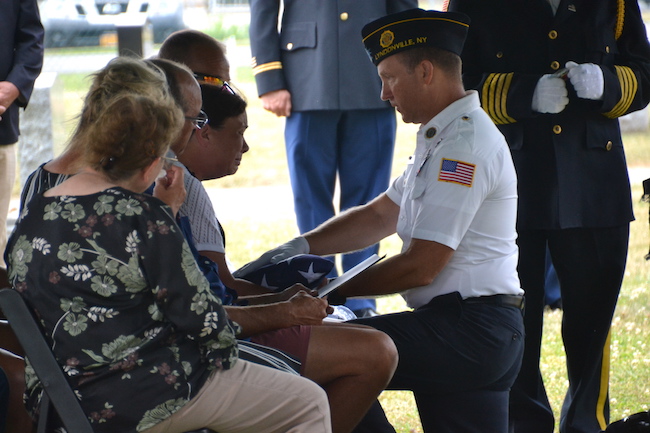
Scott Goetze, a member of the American Legion in Lyndonville, presents an American flag to Mary Francis, niece of Gerald “Bud” Hamann. Francis traveled from Montana for the service today in honor of her uncle. Family also attended from Seattle, Minnesota, South Carolina, Texas, Florida and Fort Drum near Watertown in northern New York.
Today, with his family from many states gathered in Lyndonville, Hamann was praised and mourned for his life.
“We are here to celebrate a life of heroism,” said State Assemblyman Steve Hawley.
Hamann and his American regiment helped the Filipino people and then was subjected to “one of history’s most horrific wartime occurrences,” Hawley said.
An estimated 500 to 650 American troops died in the Bataan Death March, when they were denied food, given little water and often beaten or killed with bayonets if they fell out of line or for no reason at all. Filipino troop deaths totaled 5,000 to 18,000 in the march.
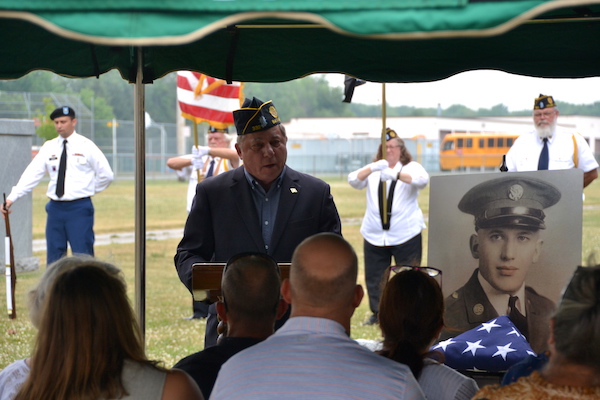
Assemblyman Steve Hawley said the Hamann led “a life of heroism.”
After the march, the survivors were packed into sweltering railroad boxcars and taken another 25 miles to a prisoner of war camp. Hamann survived that. At the camp, however, he was the 29th man to die on July 25, 1942 due to illness, and the 1,187th prisoner to perish.
His death was recorded by a fellow soldier on the backside of a label from a can of condensed milk. Hamann’s fellow soldier wrote he died at 7 p.m. at Cabanatuan on July 25, 1942. He died in barracks # 4, in POW Camp # 1, Cabanatuan.
“How do we know that?” said Matthew Atkins, a chaplain with the 10thMountain Division at Fort Drum. “Because these heroic men loved one another enough to record it. Because of them, despite their conditions, despite the cruelty, despite the inhumanity, they would not be abased. Each one mattered. Each life sacred. Each brother, inestimably valuable.”
Hamann and his regiment were lacking in food, ammunition and weaponry. After Japan attacked Pearl Harbor, crippling the U.S. Pacific operations on Dec. 7, 1941, Japan then turned to the Philippines.
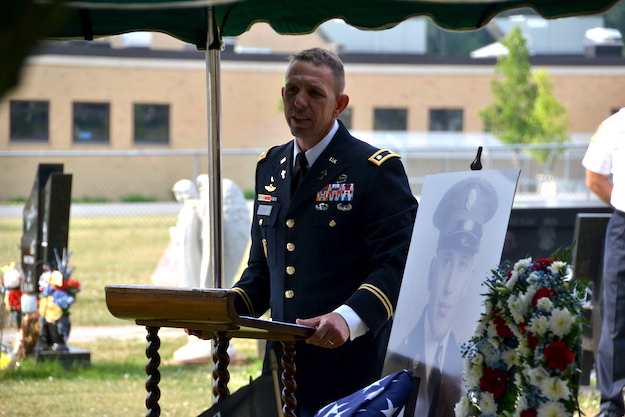
Matthew Atkins, a chaplain with the 10th Mountain Division at Fort Drum, speaks at the service today for Gerald Hamann. The soldiers with Hamann on the Bataan Death March cared for each other in the face of brutal inhumanity, Atkins said.
The overmatched U.S. and Filipino forces would hold off the Japanese for nearly four months until surrendering on April 9, 1942.
Those four months altered the Japanese timetable in the war, and that extended time made a difference for the Allies who would emerge victorious, said Atkins.
But April 9, 1942, the day of the surrender, may have been “the most brutal time for any soldier every wearing the American uniform,” he said.
The soldiers, already starving and weakened, would be subjected to “unthinkable brutality.”
Early enlister
Hamann enlisted in New York National Guard on Jan. 17, 1938, when he wasn’t quite 18. He asked to be released from National Guard early so he could enlist in Active Duty with Army.
He was stationed 14 months in Hawaii and then was sent to the Philippines, arriving in Manilla in April 1941. It didn’t seem too dangerous of an assignment, Atkins said.
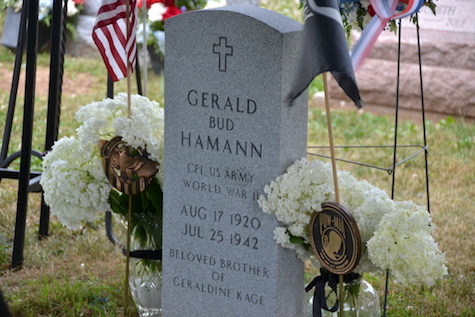
Gerald Hamann’s grave stone notes he is the “beloved brother of Geraldine Kage.”
But then Pearl Harbor was attacked on Dec. 7, 1941, and 10 hours later the Japanese would attack U.S. military installations in the Philippines. Hamann and the 31st Infantry Division were suddenly in an active combat zone.
Hamann had a twin sister at home, Geraldine. She was married to Herman Kage, who was fighting Germans in Europe.
When a telegram arrived from the War Department, she couldn’t bear to open it, not knowing if it was the worst news about her husband or brother.
Hamann’s grave stone at Lynhaven notes he was the brother of Geraldine.
His remains haven’t been released yet. His family said they are grateful for the military’s efforts to identify and honor him.
Atkins said the U.S. military is committed to trying to identify as many soldiers as possible, and to bring them home.
He noted that Hamann comes from a family where at least eight members have served in the military since World War I. He comes from the town with “a statistically huge veteran population.”
Hamann may not have died in “a blaze of glory” but he and the other soldiers in the Bataan Death March and the POW camps showed each other love while suffering “day after day, mile after mile, indignity upon indignity,” Atkins said.
“We are horrified, and our sense of humanity wounded by the misery that CPL Hamann and so many others endured,” Atkins said. “And we are astounded by their character. These were men of honor, who fought valiantly with next to nothing, endured unspeakable conditions.”
“They lived the most arguably difficult days with principle. In their suffering, they did not surrender their souls.”
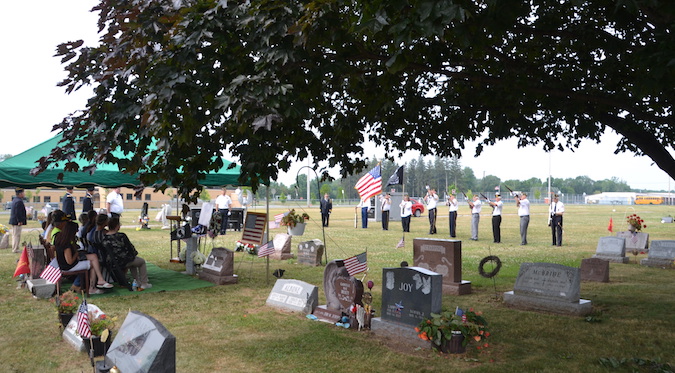
Family members attend the service at Lynhaven Cemetery today. The Honor Guard does a 21-gun salute for Hamann. Bogan & Tuttle Funeral Homes assisted the family in arranging the service.
‘Among the finest men this country has ever produced’
Hamann and the soldiers on the march, later in the railroad boxcars and then in the POW camps would share bread crumbs and rice, and care for each other.
Atkins quoted lines from America the Beautiful:
“O beautiful for heroes proved in liberating strife,
Who more than self, their country loved
And mercy, more than life.”
“Perhaps no collective in American history has embodied that verse more than the soldiers from Bataan,” Atkins said.
The service today for Hamann is “a day of sorrowful remembrance, and grateful thanksgiving.”
Hamann died nearly 79 years ago.
“Many of you still mourn over what might have been – the life Gerald should have lived,” Atkins said. “There is no way we can know what might have been in Gerald’s life – and we are left to judge the whole by its quality of humanity in sacrifice as opposed to its quantity of days. By that standard, CPL Gerald Hamann was among the finest men this country has ever produced.”
Mary Francis, niece of Hamann, thanked the Honor Guard, American Legion members, speakers and others for their presence today at the service.
“Thank you for acknowledging the sacrifice of my mother’s brother,” Francis said.
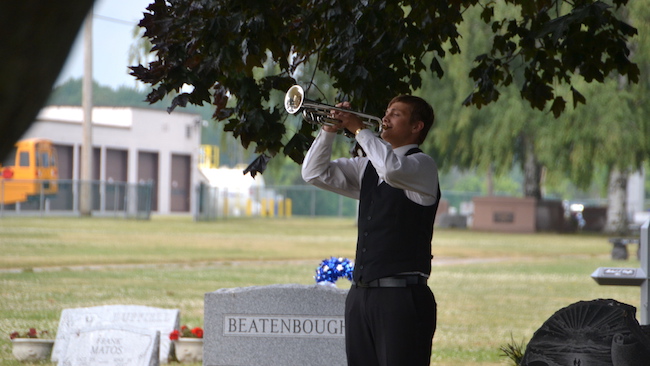
Preston Kage, a relative from Minnesota, plays Taps during the service today at Lynhaven.
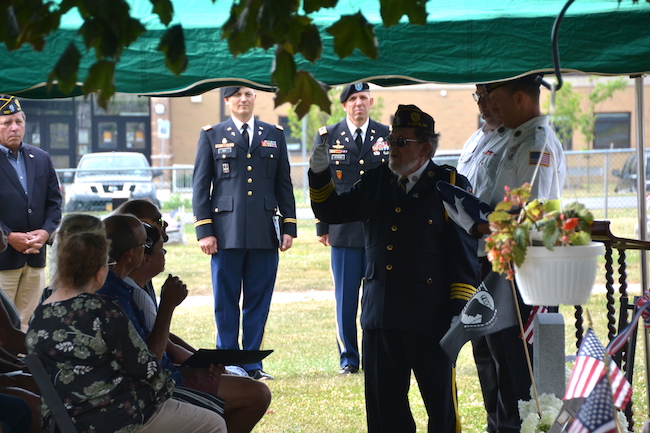
Gary Befus, leader of the Honor Guard, presents the family with three spent shell casings that represent service, honor and duty.
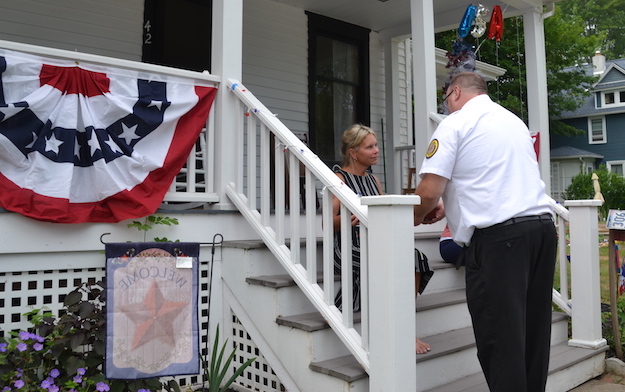
Steve Goodrich, American Legion commander in Lyndonville, presents an American flag to Kathy Kage, one of Hamann’s nieces, today at the family home on Church Street. Goodrich presented the flag after the service at the cemetery. Kage submitted DNA that provided a match to her uncle’s remains in the Philippines.





































































